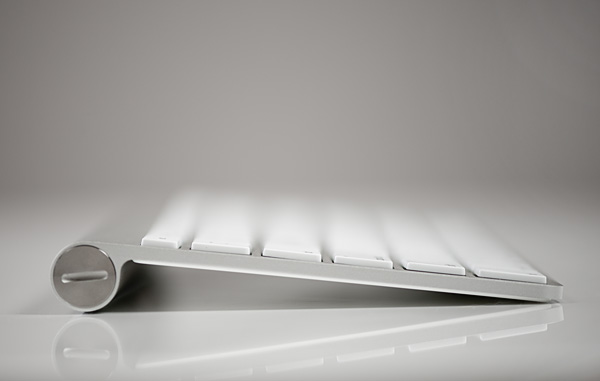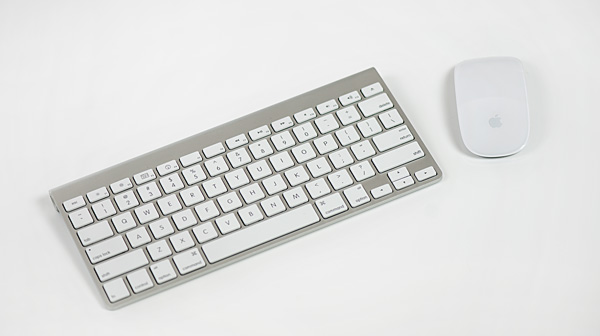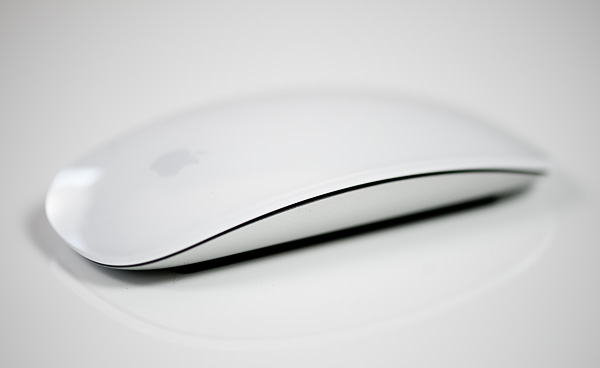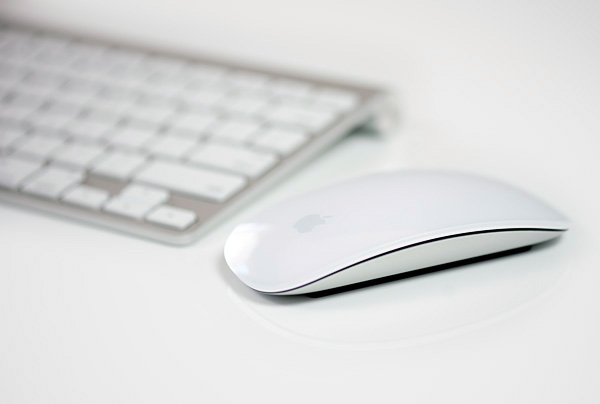The 27-inch Apple iMac Review (2011)
by Anand Lal Shimpi on May 27, 2011 2:30 AM ESTThe Peripherals
I've never been a fan of wireless peripherals - I didn't want more things to charge. Last year I finally broke down and bought a wireless mouse: Microsoft's Wireless Mobile Mouse 4000. I didn't buy it for mobility, I just liked the form factor.
The iMac comes with all wireless peripherals. In fact, if you stick with WiFi for network access, there's only a single cable you need going to the iMac: power. By default you get Apple's Wireless Keyboard and a Magic Mouse.
The Wireless Keyboard is a Bluetooth keyboard that runs off of two AA batteries. It pairs effortlessly with the iMac and I didn't encounter any issues with interference in using it. The keyboard seems to burn through batteries quicker than the mouse, perhaps that's because I type far too much or there's an issue with power management under OS X. After a week of use I'm down to 81% on a fresh pair of batteries (this is my second set).
The keyboard itself is a lot like Apple's standard aluminum keyboard, just wireless and more compact. Apple chopped off the dedicated home/end key island as well as the numeric keypad. Under OS X Cmd + Left/Right Arrow take the place of Home/End for me so part of the sacrifice isn't a problem, but the missing numeric keypad is. I do entirely too much data entry (ahem, benchmarks) to not have a dedicated numeric keypad, and for some reason Apple doesn't offer the Wireless Keyboard with one.
If you don't type tons of numbers every day however, the Wireless Keyboard is really nice. Apple had to stick a function key to the left of the control key, which is a bit bothersome (leave my control/option/cmd row alone) but it's nothing you can't get used to. The footprint is great. I have a giant desk, but I always seem to run out of desk space. The Wireless Keyboard makes it so that I can reclaim a small amount of high value desk area.
Typing feel and keyboard angle are both great - no complaints there. I'm a fan of Apple's keyboards.
Pointing devices designed in Cupertino are another story entirely. I've never liked Apple's mice. It was a big enough problem that when I first tried my Month with a Mac experience I ditched Apple's mouse. There was no way I was going to give the platform a fair shake if I had to use that thing. Since then Apple has at least enabled double clicking - the surface of the Magic Mouse is touch sensitive, click with your right finger and you get a right click. The Magic Mouse has no scroll wheel but drag your finger around on its surface and you get the best scrolling experience on a physical mouse.
The Magic Mouse is also a Bluetooth device that quickly pairs with the iMac. I noticed under Windows there's always a second or two of lag before it recognizes the mouse whereas it's useable as soon as you can see it under OS X.
My complaints about the Magic Mouse are three-fold. As I've mentioned before, the Magic Mouse doesn't have soft rubber feet that glide around on your desk. Instead you get two hard plastic strips that just seem to scrape against all surfaces. Tracking isn't a problem, but it's not a pleasant experience.
The other issue I have is the form factor itself. Microsoft's Wireless Mobile Mouse 4000 is small but it has a nice curve to it that seems to match my hand very well. The Magic Mouse on the other hand doesn't conform to any part of my body. I can lay my hand flat on it but either I'm not conditioned to do that or that's not a very comfortable way to use the mouse for long periods of a time.
Finally there's the clicking noise it makes. Modern mice seem to have a solid but more muted click, whereas the sharp click of the Magic Mouse reminds me of the past decade of Apple mice. I assume that's what Apple was going for, but Apple's market share has grown considerably in the past 10 years - it's ok to let go of some traditions.
Apple does offer the Magic Trackpad as a no-cost option. I have a love/hate relationship with the Magic Trackpad as a pointing device. Scrolling and gestures are great on it, but I prefer a normal mouse for most everything else.
















139 Comments
View All Comments
joe_dude - Saturday, May 28, 2011 - link
But the thing's essentially a 3-year old PC. Why the heck would I want to pay more to downgrade?Of course Macs hold their resell value... it's not for gaming, so even a 5 year old Mac seem pretty fast using regular apps.
Even if it can be used as just a monitor, who the heck wants the extra dead weight? All-in-ones will always be a compromise. The point of having a desktop PC is *not* to compromise. Otherwise, a laptop can do the job.
Kristian Vättö - Saturday, May 28, 2011 - link
Good luck finding a Sandy Bridge CPU and AMD 6000-series graphics in a 3-year-old PC.A LOT fits between regular apps and gaming. Photo, music and video editing are the first that come to my mind. For some people, Macs are the preferred option due to Logic and Final Cut. When you don't have the $ for Mac Pro, iMac is your best option. In the end, iMac is far more powerful than MBPs or other laptops.
Sure, AIO form factor has its downsides but it's pretty clear that Apple has never been interested on enthusiasts. For an Average Joe, iMac is a brilliant machine, which explains why it sells so well too.
joe_dude - Saturday, May 28, 2011 - link
Don't be hoodwinked. Any 3-year old SLI rig would beat the pants off this thing. Remember, it's a _mobile_ CPU with a _mobile_ GPU; a laptop pretending to be a desktop.Any middle-of-the-road SFF/ITX machine with a Radeon 6850 would beat the pants off this thing. This thing is all about form over function. Save the money and get a 30" Dell monitor instead.
Kristian Vättö - Saturday, May 28, 2011 - link
I would like to know where you can find a 3.4GHz quad core mobile CPU. The CPUs are standard desktop parts and i7-2600 is actually one of the fastest CPUs that is available today.Your 3-year-old SLI rig beat or come close in GPU performance but the iMac would run circles around it in CPU bound tests. If you talk about performance, then you must include every area, not just gaming and graphics tests. Or then specify that you are only talking about gaming performance.
iMac's value isn't that bad when you consider the value of the screen. 30" monitor will cost you at least 1000$ so that leaves you another 1000$ for the actual computer. Sure, that is more than enough to get the similar components but the iMac won't end up being more than ~200$ more expensive (which is pretty good when talking about Apple).
Nobody is forcing you to buy an iMac so that is why I don't get why you are complaining. Clearly, there are people who want one, even if it is a compromise. You can stick with your PC if that is what you prefer.
joe_dude - Saturday, May 28, 2011 - link
Ah yes, you're right on the CPU. For some reason I thought the dual channel 1155 socket meant it was a mobile CPU.The Dell version of the 27" can be had ~$800. Of course, retail price is ~$1000, and Apple wouldn't charge less, of course.
The 3.4 GHz i7 option costs extra (is it really $500???), so we're talking a ~$1700 PC (sans monitor). We're talking a full out i7 SLI rig vs. a weaksauce iMac for that price.
I'm a gamer, but not crazy enough to spend that on an all-in-one!
Kristian Vättö - Saturday, May 28, 2011 - link
I think you should really check your facts before you post. The i7 option in iMac is 200$, not 500$. Sure, it is still overpriced but BTOs in general are. The iMac can also be had for less when you look at resellers like MacMall so IMO, the only fair comparison is to look at retail prices.For 1200$, you can build a nice PC but definitely not an SLI system (unless you go with lower-end GPUs, though that kills the idea of SLI IMO).
If we wanted to be fair, we should compare the iMac to an OEM PC, not self-built one. Why? Because you are paying for the labor and service in the iMac as well. That is why OEM PCs cost more than the ones you build on your own. I know the joy of building your own computer is unbeatable and I love it too but when comparing things, you have to understand where the costs come from. It's a whole new question whether it is worth it for you to pay the extra for service etc.
I'm not trying to sell you an iMac but to make you understand where the costs come from and in the end, why the iMac isn't that bad value. For gamers, the iMac is and will always be a very compromised system.
donnyg - Saturday, May 28, 2011 - link
As SmithJ mentioned, a i7 computer with PCIe 16x/4x is only around $750 USD and that's including a GPU.You can easily get 2x HD6950x/6970s which do much better in that resolution anyway because of the VRAM requirements.
KoolAidMan1 - Sunday, May 29, 2011 - link
Throw in the same 2560x1440 IPS display and you're adding at least another $1000 to the whole package. Then there's operating system and the bundled software, and the fact that all-in-ones from any PC builder costs more than a standard ATX based PC.Given everything involved, the iMacs are actually a pretty good deal. Really fast, amazing display, tiny footprint, and silent. I still build my own PCs and I'll never give that up, but I love having it plugged into my iMac as a display and using both.
smithj - Saturday, May 28, 2011 - link
My shop runs iMacs because they're just so good with size and noise - we're really damned pleased that we've ditched the old noisy workstations and they're fast enough for what we want to do!But he's kind of right. For a consumer, iMacs aren't the best of value. A small mATX computer with an i7 2600 (what 99% of people going to do with an i7 I don't know) and an AMD HD 5850 only costs around $700, and this isn't even looking around. Throw in a 27" Ultrasharp or ACD and your whole computer is going to cost only $1500-1700.
They're popular because they're:
- Small
- Amazing looking
- Perform well enough
- Quiet
- Covered by the best consumer warranty in the market
- Good out of the box, no extra work required
Its got nothing to go with specs, most people who buy them frankly don't care about the specs. $500-700 extra to pay for a generally weaker computer is a bit annoying but I'm getting old and frankly the warranty service, ease of use, and lack of noise is loved by all.
smithj - Saturday, May 28, 2011 - link
We can't edit post. The point I'm making is that in a price/spec game, the iMacs are nowhere near as good as DIY PCs but there are some things that can't be directly put in a small HTML table.Apple to this day seems to be one of the few companies, if not the only, who understands this important factor.